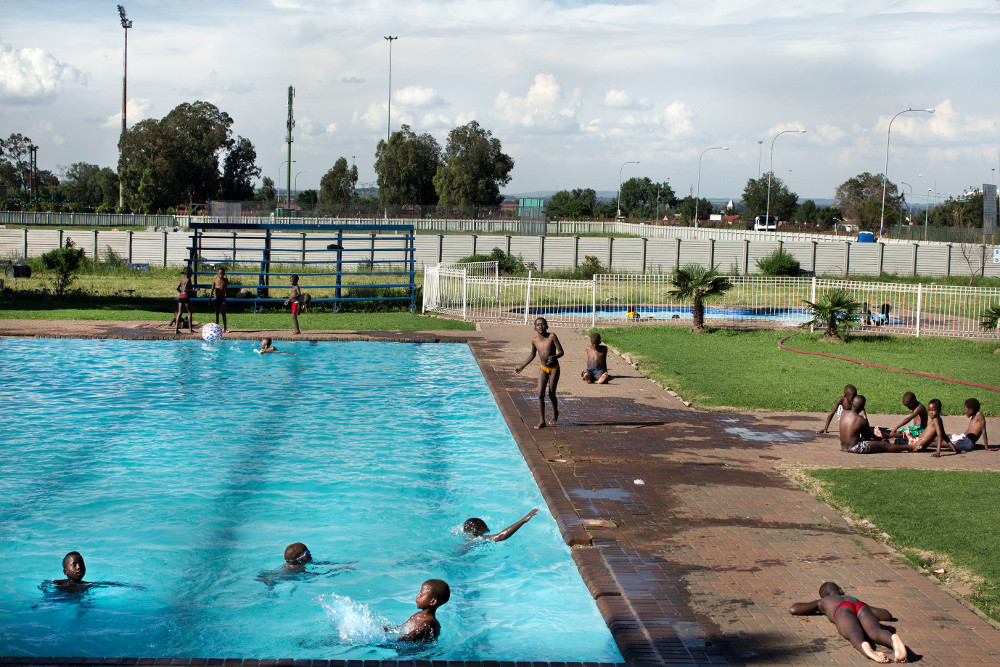An image of a household in Sharpeville from Jabulani Dhlamini's photo series Recaptured.
In the public imagination, the memory of Sharpeville is frozen on March 21 1960, the day 69 people were shot and killed by the police during an anti-pass protest. About 180 more were injured.
It is some of these survivors and their unresolved trauma that form part of Jabulani Dhlamini’s Recaptured, an extensive body of photographic work covering infinite aspects of the Sharpeville massacre.
His aunt, Nora Tshabalala, was doing her washing on the day of the massacre. She heard the commotion of people running and, moments later, she could no longer feel her legs. Now with a permanent limp, Tshabalala has to walk with medical issue boots, which have to be replaced regularly at the Chris Hani-Baragwanath hospital in Soweto.
Her boots, the result of being at the wrong place at the wrong time, stand as a symbol of all those who marched on that pivotal day in the history of South Africa.
 The girl with a tattoo (Tsepo Gumbi, Re-Imagining Sharpeville)
The girl with a tattoo (Tsepo Gumbi, Re-Imagining Sharpeville)
An outsider to Sharpeville, Dhlamini’s work stands in contrast to that of Tsepo Gumbi, a resident of the township until 2014. Whereas Dhlamini’s works look at inherited trauma and the symbols of death and mourning, Gumbi looks at Sharpeville today and its political marginality.
“There is development in Sharpeville, but not like what you would expect,” Gumbi says. “The reason for that is its proximity to or [distance] from Johannesburg. Soweto and Sharpeville are two of the most famous townships in South Africa, historically. But if you compare the two, Sharpeville is nowhere. Politicians like to do something where the media can see it happening. Sharpeville is remembered only at this time, typically, which irritates us.”
Sharpeville, just outside Vereeniging, is about 70km south of Johannesburg. Soweto is about 27km away.
Gumbi has created two photographic series relating to different aspects of how he sees his township – A Place Called Sharpeville and Re-imagining Sharpeville. The first is largely landscapes and architectural design; the second is more lyrical, in his words, a quest to “developing a new vocabulary”.
As he works in his shared office at the Market Photo Workshop, Gumbi pauses on a photograph depicting a balmy poolside scene in which a bunch of youngsters are enjoying an afternoon of swimming. “This is my favourite place to photograph. It is also in my other body of work [Re-imagining Sharpeville]. This used to be where I’d have fun, on Saturdays, or after school. That would be me,” he says, pointing to a boy in underpants near the edge of the pool. The boy lies face down warming his torso while other groups of kids play about.
Gumbi’s vantage point is elevated, perhaps shot from the rooftop to reveal what he calls “the relative order of Sharpeville, apparently designed as a ‘model township’, if the justification of John Sharpe, a city planner is to be believed.” Gumbi says if this was the case, it later turned out to be false, because it evolved into yet another labour camp.
In Natasha Vally’s thesis The ‘Model Township’ of Sharpeville: The absence of political action and organisation, she writes: “One would expect a place this iconic to mirror the national historical narrative, because one might expect a place so remembered for a political event to be a consistent hub for political organising.
“Yet Sharpeville was neither a place of consistent organising nor a place where the quiescence of the 1960s, followed by intensified black working class resistance in the 1970s played out exactly according to the script.
“While Sharpeville being designed for order did make organising difficult, it was a combination of this and the fact that Sharpeville did provide a better lifestyle to former residents of the ‘old locations’, which had a palliative effect on the population.”
In a sense, this statement is a pivot that both photographers use to swing their works in two opposite yet non-binary directions.
Gumbi’s use of colour, and the intimacy pervading the images of Re-imagining, move them away from a central narrative, while Dhlamini’s exhaustiveness achieves this by opposite means. “When you see a crippled old person in Sharpeville, you wonder whether was it a result of the shootings or not. And when you ask, you find that you are right. And that the trauma hasn’t been dealt with right. Some cry when you interview them.”
 A public swimming pool in Sharpeville (Tsepo Gumbi, A Place Called Sharpeville)
A public swimming pool in Sharpeville (Tsepo Gumbi, A Place Called Sharpeville)
Dhlamini says his project was initiated when he was part of a learnership in 2010. Of the 10 people in the group, only two others continued with photography. Dhlamini alludes to the fact that there remains a pervading difficulty in reframing the imagery of Sharpeville.
He explains that in his use of colour, he has attempted, more often than not, to desaturate his images to draw the observer in to find multiple readings. He also uses abstraction to communicate the degrees to which the story has pulled him in and in some cases, confounded him. “I feel I spent so much time there that I inherited the trauma myself.”
With the flurry of activity in Sharpeville occurring in an annually prefigured cycle, reflecting the crass politicisation of its memorialisation, the voices of the survivors, and of future generations, are needed to free the narrative from the prison of history.
Dhlamini says his work is ongoing, with slow, almost archaeological scope. Gumbi’s quiet intervention in Re-imagining Sharpeville has a home at an upper floor exhibition space at the Market Theatre. It is symbolically hidden, a narrative that does not seek the populism of the day.